

© Copyright 1995-2023, Clay Irving <clay@panix.com>
Kingdom of Cambodia: 1953-1970 | ||
| Under the reign of King Norodom Sihanouk, Cambodia gained independence from France on 09 November 1953, and the kingdom became a constitutional monarchy under the King. Upon gaining its independence, Cambodia issued the Riel on 01 January 1955. The Riel is divisible into 100 Sen, and was issued at par with the Piastre which was completely replaced by 29 September 1955.
The National Bank of Cambodia was established on 23 December 1954 — After the country gained the independence from French Colony and after the Indochina Printing Institution was closed. The National Bank of Cambodia printed its own national currency of Riel in order to completely terminate the monetary alliance with the Vietnamese and Laos currency. Prior to 1955, see French Indo-China. | ||
National Bank of Cambodia | ||
1955-1956 ND Issue | ||
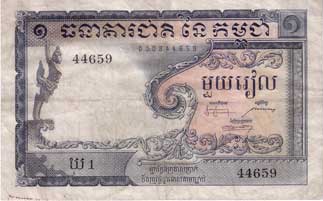 | P1 - 1 Riel Serial Number: 44659 Front: Kinnari figure with raised arms at left Back: Royal houseboat at left Watermark: Elephant head Signature: 1, 28 Oct 1955 Printer: Thomas De La Rue & Company, Ltd., England (Not printed on banknote) Size: 126 x 79 mm
| |
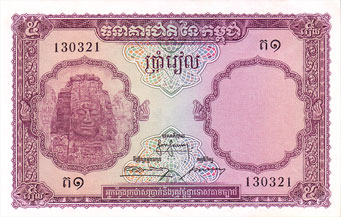 | P2 - 5 Riels Serial Number: 130321 Front: Bayon sculpture at left Back: Royal palace entrance at Chanchhaya at right Watermark: Buddha Size: 133 x 84 mm | |
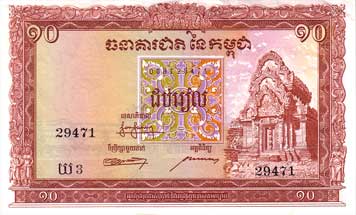 | P3 - 10 Riels Serial Number: 29471 Front: Temple of Banteay Srei at right Back: Central Market in Phnom Penh Watermark: Buddha Signature: 1, 28 Oct 1955 Printer: Thomas De La Rue & Company, Ltd., England (Not printed on banknote) Size: 139 x 85 mm
| |
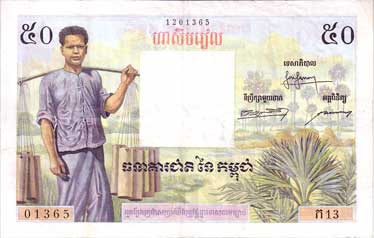 | P3A - 50 Riels, 1956 (No date on banknote) Serial Number: 01365 Front: Man with bamboo vessels at left Back: Stupas Watermark: Buddha Signature: 1, 28 Oct 1955 Printer: Banque De France (Not printed on banknote) Size: 146 x 92 mm | |
1955-1956 ND Second Issue | ||
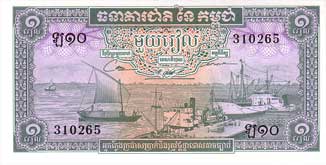 | P4c - 1 Riel Serial Number: 310265 Front: Boats and ships dockside in port Back: Royal Palace Printer: Bradbury, Wilkinson & Company, England Size: 127 x 63 mm | |
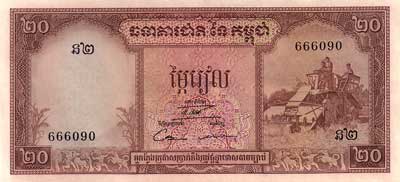 | P5d - 10 Riels Serial Number: 66090 Front: Combine harvester at right Back: Wat in Phnom Penh Watermark: Head of Buddha Size: 156 x 72 mm | |
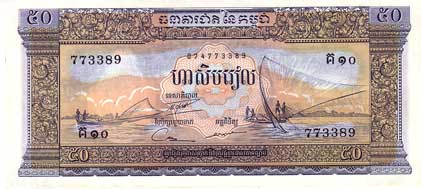 | P7d - 50 Riels Serial Number: 773389 Front: Fishnet fishing on Lake Tonlé Sap Back: Angkor Wat Watermark: Bayon stone face of Bodhisattva Lokesvara in Angkor Thom Size: 164 x 74 mm The Tonlé Sap (Cambodian meaning "Large Fresh Water River," but more commonly translated as "Great Lake") is a combined lake and river system of huge importance to Cambodia. It is the largest freshwater lake in South East Asia and is an ecological hot spot that was designated as a UNESCO biosphere in 1997. Lokesvara, "Lord of the World", is the bodhisattva of compassion. | |
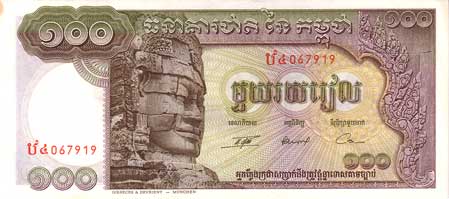 | P8c - 100 Riels Serial Number: 067919 Front: Statue of Lokesvara at left Back: Long boat at center Watermark: Head of Bhudda Printer: Giesecke & Devrient, Munich, Germany Size: 175 x 77 mm | |
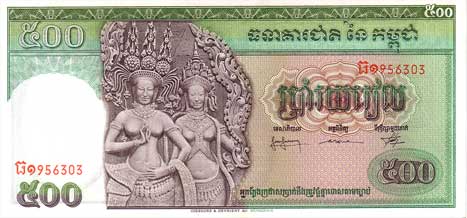 | P9c - 100 Riels Serial Number: 956303 Front: Sculpture of two women dancers called "Devatas" at center left Back: Two royal dancers in ceremonial costumes Watermark: Head of Bhudda Printer: Giesecke & Devrient, Munich, Germany Size: 182 x 85 mm | |
1962-1963 ND Third Issue | ||
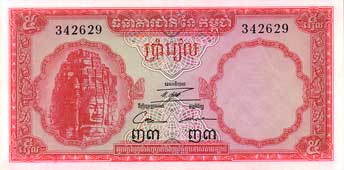 | P10 - 5 Riels Serial Number: 342629 Front: Bayon four faces of Avaloketesavara at left Back: Royal Palace entrance - Chanchaya at right Watermark: Buddha Size: 135 x 67 mm | |
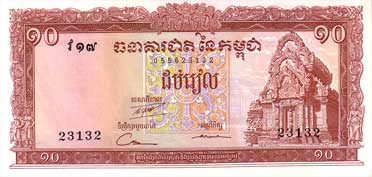 | P11c - 10 Riels Serial Number: 23132 Front: Temple of Banteay Srei at right Back: Central Market building at Phnom-Penh at left Watermark: Head of Bhudda Printer: Thomas De La Rue Size: 145 x 69 mm | |
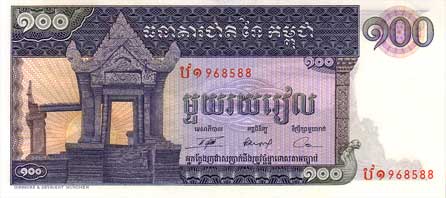 | P12b - 100 Riels (Unissued) Serial Number: 968588 Front: Sun rising behind Temple of Preah Vihear at left Back: Aerial view of the Temple of Preah Vihear Watermark: Head of Bhudda Printer: Giesecke & Devrient, Munich, Germany Size: 178 x 78 mm | |
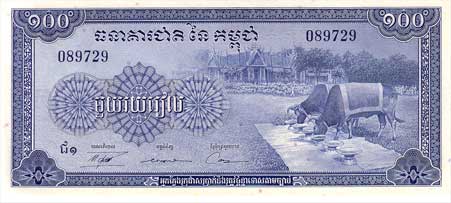 | P13b - 100 Riels (Unissued) Serial Number: 089729 Front: Ox at right Back: Three ceremonial women Printer: American Bank Note Company Size: 176 x 76 mm | |
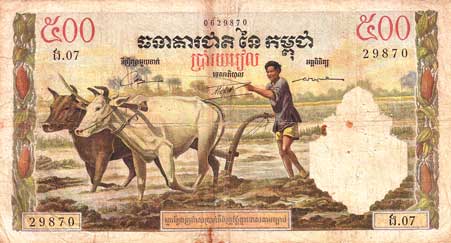 | P14 - 100 Riels Serial Number: 29870 Front: Farmer plowing with two water buffalo Back: Pagoda at right, doorway of Preah Vihear at left Watermark: Head of Buddha Printer: Banque du France Size: 176 x 95 mm | |
Khmer Republic: 1970-1975 | ||
| In March 1970, while Prince Sihanouk was absent, General Lon Nol deposed Prince Sihanouk in a coup d'état which, contrary to common belief, was not planned by the CIA. Lon Nol assumed the power after the military coup and allied Cambodia with the United States. Son Ngoc Thanh announced his support for the new government. On October 9, the Cambodian monarchy was abolished, and the country was renamed the Khmer Republic. | ||
National Bank of Cambodia | ||
1973 ND Issue | ||
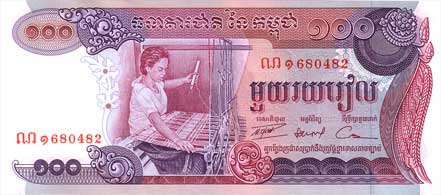 | P15 - 100 Riels Serial Number: 680482 Front: Woman weaving a mat at center Back: Angkor Wat Watermark: Man's head Printer: Thomas De La Rue Size: 172 x 76 mm | |
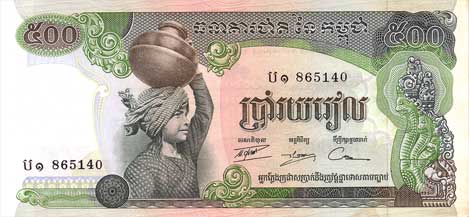 | P16a - 500 Riels Serial Number: 865140 Front: Girl with vessel on head at left Back: Rice paddy Watermark: Man's head Printer: Thomas De La Rue Size: 183 x 86 mm | |
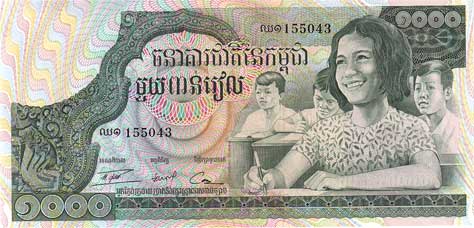 | P17 - 5000 Riels (Unissued) Serial Number: 155043 Front: School children at right Back: Head of Lokesvara at Ta Som Watermark: Size: mm | |
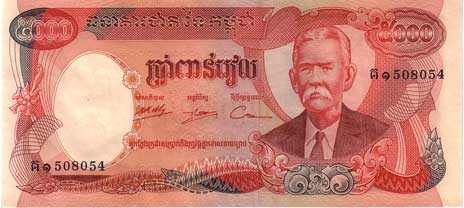 | P17A - 5000 Riels (Unissued — Only released in 2005) Serial Number: 508054 Front: Male bust at right Back: Building Watermark: Bust of man on Front side Size: 181 x 81 mm | |
Democratic Kampuchea (the Khmer Rouge/Red Khmer age): 1975-1979 | ||
Democratic Kampuchea is the government that ruled Cambodia from 1975-1979. This regime is governed by Pol Pot, Ieng Sary and Kieve Samphan and other subordinates. This regime is notorious for its "auto-genocide" which means slaughtering its own people (having the same nationality as the leaders). Democratic Kampuchea is considered as one of the weirdest regimes in the world, due to its destruction of its own nation and people. On 17 April 1975, the National Bank of Cambodia was closed, the banking system was totally destroyed, the National Bank of Cambodia building was ruined, and the Riel banknotes were no longer used. John Pilger described the scene after visiting in 1979, "When the afternoon monsoon broke, the streets nearby ran with money as thousands of brand-new banknotes washed away in the gutter. Children, orphans, collected and dried them for fuel; I can still hear the crackle as the money burned." | ||
Bank of Democratic Kampuchea | ||
1975 Issue | ||
| These notes showing the Khmer Rouge defending the country against Capitalists were made by the Khmer Rouge, but were never issued. The new regime under Pol Pot instituted an "agarian moneyless society." | ||
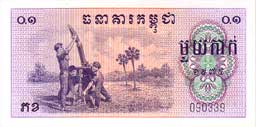 | P18 - 0.1 Riel (Unissued) Serial Number: 090339 Front: Motar crew Back: Women threshing rice Size: 100 x 50 | |
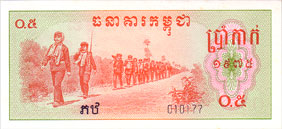 | P19 - 0.5 Riel (Unissued) Serial Number: 010177 Front: Troops marching Back: Bayon sculpture at left, metalworking at center right Size: 110 x 50 | |
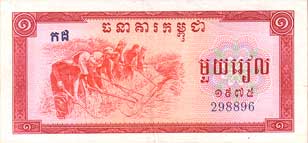 | P20 - 1 Riel (Unissued) Serial Number: 298896 Front: Women farm workers at left Back: Women operating machine Size: 120 x 56 | |
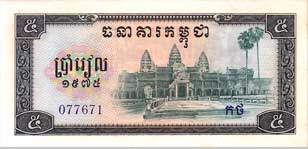 | P21 - 5 Riel (Unissued) Serial Number: 077671 Front: Angkor Wat at center right Back: Landscaping crew Watermark: Angkor Wat Size: 120 x 57 | |
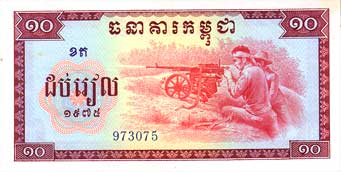 | P22 - 10 Riel (Unissued) Serial Number: 973075 Front: Machine gun crew Back: Harvesting rice Size: 133 x 68 | |
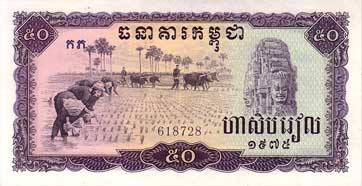 | P23 - 50 Riels (Unissued) Serial Number: 618728 Front: Planting rice at left, Bayon sculpture at right Back: Women's militia Watermark: Angkor Wat Size: 163 x 73 | |
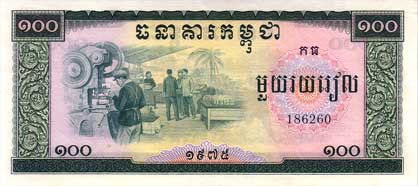 | P24 - 100 Riels (Unissued) Serial Number: 186260 Front: Factory workers at center left Back: Rice workers Watermark: Angkor Wat Size: 163 x 73 | |
People's Republic of Kampuchea: 1979-1993 | ||
| The Khmer Rouge collapsed in 1979, and Heng Samrin set up a new Communist government, the People's Republic of Kampuchea (PRK). He became chairman of the People's Revolutionary Council of the PRK in 1979. In 1981 he became chairman of the Council of State and secretary-general of the People's Revolutionary Party. Though at first he was the effective leader of the government, he quickly lost much of his power when the more moderate Hun Sen became Prime Minister in 1985. As Vietnamese influence declined, Heng began losing his posts, including the post of secretary-general in 1991 and chairman of the council of state in 1992. When King Norodom Sihanouk was restored in 1993, Heng was given the honorary title of Samdech, and was made honorary chairman of Hun Sen's Cambodian People's Party.
On 10 October 1979, the People's Bank of Cambodia called "Bank of Cambodia" was re-established as a Central Bank of the Country by sub-decree No 1211 dated 10 October 1979 of the Council of the Revolutionary People of Cambodia. The bank extended to 20-provincial and municipal locations in the country. The People's Bank of Kampuchea re-issued the Riel banknotes on 20 March 1980. Because there was no money for it to replace and a severely disrupted economy, the central government gave away the new money to the populace in order to encourage its use. The National Bank of Cambodia was publicly called "Red Bank" or "Banque Rougei", because this term was short and easy for public to say and the term "Red Bank" represented the bravery in overcoming difficulties and the patriotism of National Bank of Cambodia. | ||
People's Bank of Democratic Kampuchea | ||
1979 Issue | ||
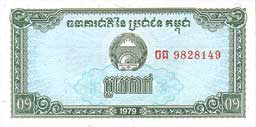 | P25 - 0.1 Riel (1 Kak), 20 March 1980 Serial Number: 9828149 Front: Arms at Center Back: Men plowing with water buffalos Size: 100 x 50 mm | |
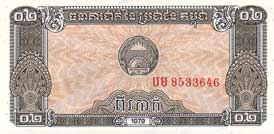 | P26 - 0.2 Riel (2 Kak), 20 March 1980 Serial Number: 8533646 Front: Arms at Center Back: Rice workers | |
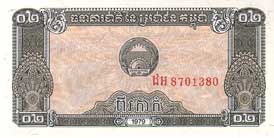 | P26 - 0.2 Riel (2 Kak), 20 March 1980 Serial Number: 8701380 Front: Arms at Center Back: Rice workers | |
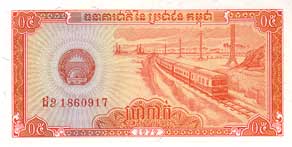 | P27 - 0.5 Riel (5 Kak), 20 March 1980 1860917 Front: Arms at left, modern passenger train at right Back: Men fishing from boats with nets Size: 114 x 57 mm | |
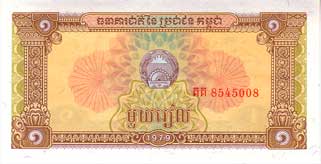 | P28 - 1 Riel (10 Kak) Serial Number: 8545008 Front: Arms at center Back: Women harvesting rice, buffalos and palm trees Size: 125 x 62 mm | |
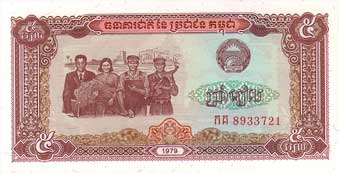 | P29 - 5 Riels 8933721 Front: Four people at left — an office worker in a suit carrying papers, a woman carrying harvested rice, a factory worker carrying a hammer, and a soldier carrying a gun, arms at upper right Back: Independence from France monument (now Victory monument) UV: blue fluorescent fibers Size: 132 x 66 mm | |
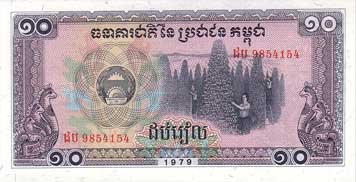 | P30 - 10 Riels Serial Number: 9854154 Front: Harvesting fruit trees at right, arms at left, Three-headed naga at lower left and right Back: School UV: blue fluorescent fibers Size: 140 x 70 mm | |
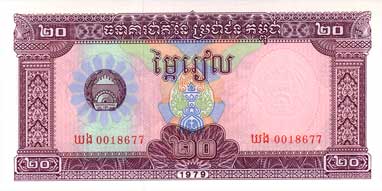 | P31 - 20 Riels Serial Number: 0018677 Front: Arms at left Back: Water buffalo hauling logs Watermark: Arms Size: 149 x 74 mm | |
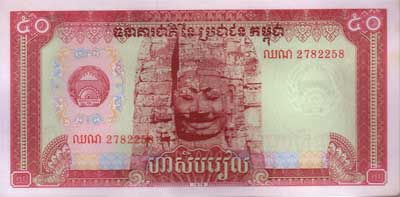 | P32 - 50 Riels Serial Number: 2782258 Front: Bas-Relief of Avaloketesavara face in center, arms at left Back: Angkor Wat Watermark: Arms Size: 156 x 77 mm Avalokitesvara, literally "Lord who looks down", is a bodhisattva who embodies the compassion of all Buddhas. He is one of the more widely revered bodhisattvas in mainstream Mahayana Buddhism. In China and its sphere of cultural influence, Avalokitesvara is often depicted in a female form known as Guan Yin. (However, in Taoist mythology, Guan Yin has other origination stories which are unrelated to Avalokitesvara.) | |
1987 Issue | ||
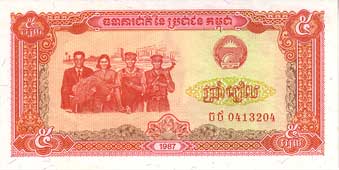 | P33 - 5 Riels Serial Number: 0413204 Front: Four people at left — an office worker in a suit carrying papers, a woman carrying harvested rice, a factory worker carrying a hammer, and a soldier carrying a gun, arms at upper right Back: Independence from France monument (now Victory monument) UV: red fluorescent serial number on front, blue fluorescent fibers Size: 132 x 66 mm | |
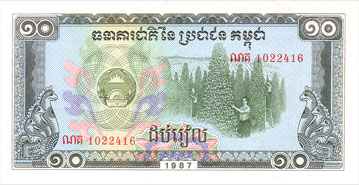 | P34 - 10 Riels Serial Number: 1022416 Front: Harvesting fruit trees at right, ams at left Back: School Size: 140 x 70 mm | |
Peoples National Bank of Cambodia | ||
1990-1992 Issue | ||
| ||
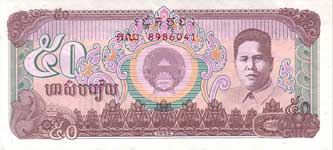 | P35 - 50 Riels Serial Number: 8986041 Front: Arms at center, portrait of Son Ngoc Minh at right Back: Unloading ships at the port UV: Blue and green fluorescent fibers Size: 130 x 59 mm Son Ngoc Minh (1920-1972), also known as Achar Mean, was a Cambodian communist politician whose first notable career achievement was in 1950 when he was appointed the head of provisional revolutionary government of the United Issarak Front organized at Hongdan. In 1950, he formally declared Cambodia's independence after claiming that the UIF controlled one third of the country. Along with Tou Samouth, Minh founded the Khmer People's Revolutionary Party (KPRP) in August 1951.
| |
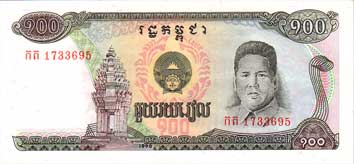 | P36 - 100 Riels Serial Number: 1733695 Front: Arms at center, Independence from France Monument (now called Victory Monument) at center left, portrait of Son Ngoc Minh at right Back: Workers tapping rubber trees UV: Blue fluorescent fibers Watermark: Stylized lotus flowers Size: 138 x 68 mm | |
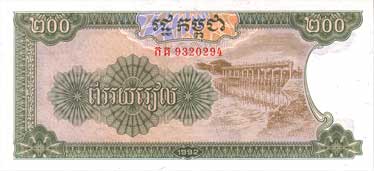 | P37 - 200 Riels Serial Number: 9320294 Front: Dam and floodgates at right Back: Bayon statute at Angkor Wat Watermark: Stylized lotus flowers UV: blue fluorescent fibers Size: 146 x 67 mm | |
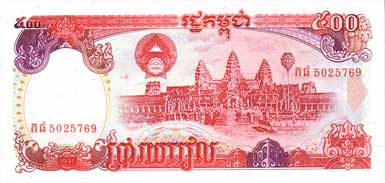 | P38 - 500 Riels Serial Number: 5025769 Front: Angkor Wat at center, arms at upper center Back: Mythical animal statue at left, cultivating with tractors at center Watermark: Bayon sculpture head UV: blue fluorescent fibers Size: 150 x 71 mm | |
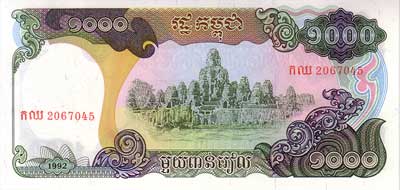 | P39 - 1000 Riels (Unissued) Serial Number: 2067045 Front: Bayon temple in Angkor Wat Back: Fisherman fishing with large nets in Lake Tonie Sap Watermark: Chinze UV: red fluorescent serial numbers Size: 156 x 74 mm | |
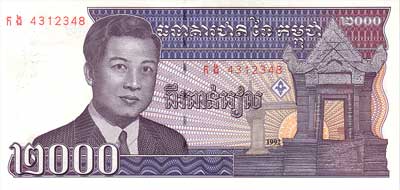 | P40 - 2000 Riels (Unissued) Serial Number: 4312348 Front: King N. Sihanouk at left, sun rising behind Temple of Preah Vihear at left — Similar to the front of P12 UV: Blue and green fluorescent fibers Size: 156 x 74 mm | |
Regional Issue - Khmer Rouge Influence: 1993 ND Issue | ||
| In 1993, Cambodia printed a regional series of money for use in Khmer Rouge occupied areas of northwest Cambodia to be used in exchange for Thailand Baht. The notes feature pictures of workers and carvings, and are quite colorful. The notes were used up to the surrender of the Khmer Rouge in 1998. After some time the issue was ordered destroyed, but examples are known to exist. However, deceptive forgeries of these notes also exist. Khieu Samphan was the president of the state presidium of Democratic Kampuchea from 1976 until 1979. After the Vietnamese invasion of Cambodia and subsequent fall of the Khmer Rouge in 1979, Samphan led a rebel government which accorded a level of international recognition until 1982. In 1985 he officially succeeded Pol Pot as leader of the Khmer Rouge, and served in this position until he surrendered to the Cambodian government in 1998. In 1982 he was appointed Vice President in charge of foreign affairs of the Coalition Government of Democratic Kampuchea and from 1991 to 1993 he served in the Supreme National Council as Khmer Rouge representative. | ||
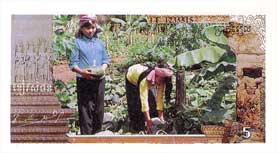 | R1 - 5 Riels Serial Number: 1 F 1235515 Front: Children harvesting vegetables, temple carvings left and right, signature of President Khieu Samphan Back: Caravan of oxcarts, temple carvings at left Size: 108 x 60 mm | |
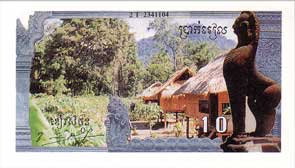 | R2 - 10 Riels Serial Number: 2 T 2341104 Front: Jungle village, temple carvings left and right, signature of President Khieu Samphan Back: Fishing village, temple carvings at left and right Size: 115 x 65 mm | |
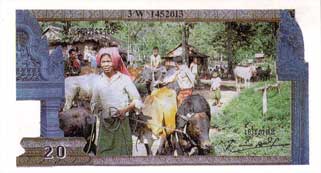 | R3 - 20 Riels Serial Number: 3 W 1452013 Front: Villagers leading oxes, temple carvings left and right, signature of President Khieu Samphan Back: Street scene, temple carvings at left and right Size: 125 x 67 mm | |
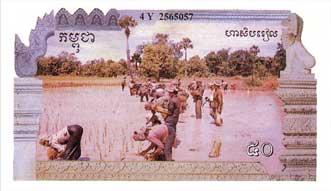 | R4 - 50 Riels Serial Number: 4 Y 2565057 Front: Planting rice, temple carvings left and right Back: Oxcarts, temple carvings at left and right, signature of President Khieu Samphan Size: 129 x 75 mm | |
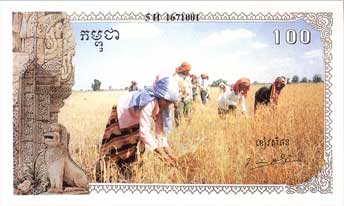 | R5 - 50 Riels Serial Number: 5 H 1671001 Front: Harvesting rice, temple carvings left and right, signature of President Khieu Samphan Back: Angkor Wat, temple carvings at left and right Size: 134 x 80 mm | |
Republic of Cambodia: 1993-Present | ||
| On October 23, 1991, the Paris Conference reconvened to sign a comprehensive settlement giving the UN full authority to supervise a cease-fire, repatriate the displaced Khmer along the border with Thailand, disarm and demobilize the factional armies, and prepare the country for free and fair elections. Prince Sihanouk, President of the Supreme National Council of Cambodia (SNC), and other members of the SNC returned to Phnom Penh in November 1991, to begin the resettlement process in Cambodia.
On 30 January 1992, in the 22nd ordinary session, the 1st legislature, the National Assembly of the State of Cambodia adopted the Law on the Change of Organization's name and duty of the Bank of Cambodia from the People's Bank of Kampuchea to the National Bank of Cambodia, which was promulgated by the council of state in 08 February 1992. | ||
1995 Issue | ||
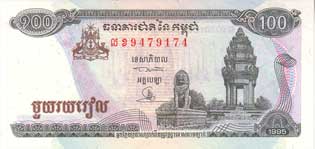 | P41 - 100 Riels Issued: 27 December 1995 Serial Number: 9479174 Front: Chinze and Independence from France Monument (now Victory Monument) at right, arms at upper left Back: Tapping rubber trees at center Watermark: Stylized lotus flowers Printer: National Bank of Cambodia Size: 123 x 59 mm | |
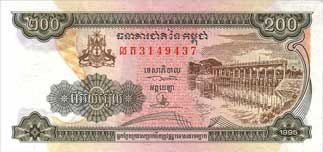 | P42a - 200 Riels, 1995, Signature 16 Issued: 27 December 1995 Serial Number: 3149437 Front: Floodgates at right, arms at upper left Back: Bayon sculpture in Angkor Wat at center Watermark: Stylized lotus flowers Printer: National Bank of Cambodia Size: 126 x 59 mm | |
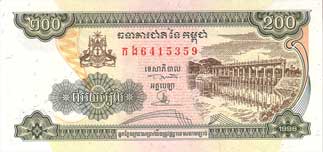 | P42b - 200 Riels, 1998, Signature 16 Issued: 27 December 1995 Serial Number: 6415359 Front: Floodgates at right, arms at upper left Back: Bayon sculpture in Angkor Wat at center Watermark: Stylized lotus flowers Printer: National Bank of Cambodia Size: 126 x 59 mm | |
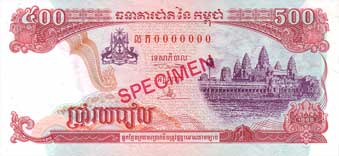 | P43s - 500 Riels Specimen Note Issue Date: 27 December 1995 Serial Number: 0000000 Front: Angkor Wat at right, arms at upper center left, date at lower right corner Back: Mythical animal at right, rice paddies at center Watermark: Stylized lotus flowers Size: 132 x 62 mm | |
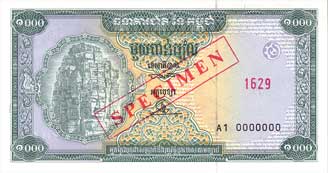 | P44s - 1000 Riels Specimen Note Issue Date: 25 March 1995 Serial Number: A1 0000000 / 1629 Front: Bayon four faces of Avaloketesavara at left Back: Prasat Chan Chaya at right Watermark: Cube design Size: 127 x 67 mm | |
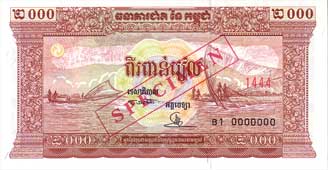 | P45s - 2000 Riels Issued: 25 March 1995 Specimen Note Serial Number: B1 0000000 / 1444 Front: Fishnet fishing on Lake Tonlé Sap. The frieze around the note is characteristic of the decorative art found on the Banteay Srei Temple. Back: Rear view of Angkor Wat Watermark: Cube design Size: 128 x 67 mm | |
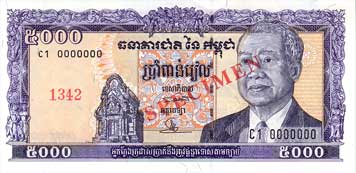 | P46s - 5000 Riels Issued: 25 March 1995 Specimen Note Serial Number: C1 0000000 / 1342 Front: King Norodom Sihanouk at right, Temple of Banteay Srei at lower left Back: Central market in Phnom Penh Watermark: King Norodom Sihanouk Size: 138 x 67 mm | |
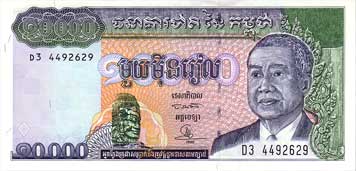 | P47b - 10000 Riels Issued: 25 March 1995 Serial Number: D3 4492629 Front: King Norodom Sihanouk at right, statue of Lokesvara at lower left center Back: Rowing a longboat during the water festival Watermark: King Norodom Sihanouk Size: 138 x 67 mm | |
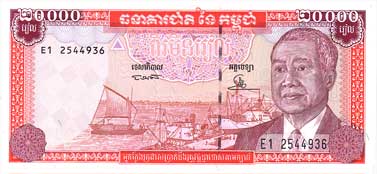 | P48 - 20000 Riels Issued: 25 March 1995 Serial Number: E1 2544936 Front: King Norodom Sihanouk at right, Port of Phnom-Penh at center Back: Throne Room at the National Palace at center Watermark: King Norodom Sihanouk Printer: Francois Charles Oberthur Size: 147 x 66 mm | |
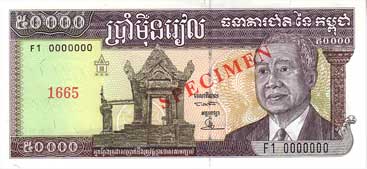 | P49s - 50000 Riels Issued: 25 March 1995 Specimen Note Serial Number: F1 0000000 / 1665 Front: Preah Vihear Temple at center, King Norodom Sihanouk at right Back: Road to Preah Vihear Temple Watermark: King Norodom Sihanouk Size: 147 x 67 mm | |
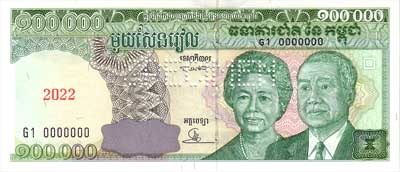 | P50 - 100000 Riels Specimen Note —- View against black background Issued: 25 March 1995 Serial Number: G1 0000000 / 2022 Front: King N. Sihanouk and First Lady at right Back: The King and First Lady receiving homage of people at center right Watermark: The King and First Lady Signature: 16 Size: 156 x 68 mm | |
1999 Issue | ||
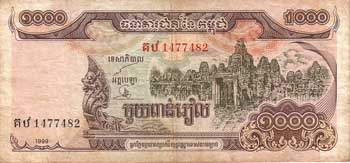 | P51 - 1000 Riels Issued: 24 December 1999 Serial Number: 1477482 Front: Bayon temple symbolizing the glorious culture of the Khmer people, naga heads sculpture at right center Back: "Troh" bridge construction along the National Road No 6. Watermark: Stylized lotus flowers Signature: Cheo Chanto Size: 136 x 64 mm | |
2001-2002 Issue | ||
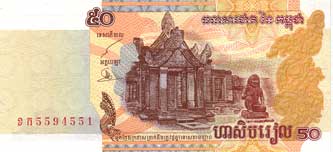 | P52 - 50 Riels, 2002 Issued: 29 August 2002 Serial Number: 5594551 Front: Banteay Srei Temple emerges in the center. On the right is the Norak Singha. On the left is the sculture of naga serpent. Back: The sluice "Tek Thla", along the National Road No 3. Watermark: Bayon sculpture in Angkor Wat Signature: Cheo Chanto The Preah Vihear Temple or Prasat Preah Vihear, is a Khmer temple situated atop a 525-metre (1,720 ft) cliff in the D‚ngrÍk Mountains, in the Preah Vihear province of northern Cambodia and near the border of the Kantharalak district (amphoe) in the Sisaket province of eastern Thailand. In 1962, following a significant dispute between Thailand and Cambodia over ownership of the temple, the International Court of Justice (ICJ) in The Hague awarded the ownership to Cambodia. | |
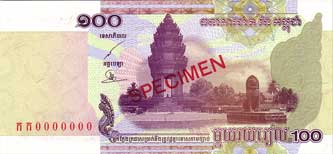 | P53s - 100 Riels, 2001 Specimen Note Issued: 09 August 2001 Serial Number: 2977757 Front: Independence Monument at right, naga heads sculpture at lower left center Back: Students and school Watermark: Multiple links of text Signature: Cheo Chanto Independence Momument was built in Phnom Penh in 1958 as a memorial to Cambodia's war dead after the gaining of independence from France in 1953, the monument, built in the Angkorian style, consists of five levels decorated with 100 snake heads. | |
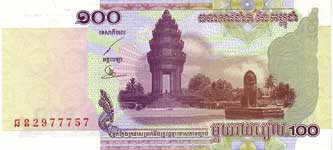 | P53 - 100 Riels, 2001 Issued: 09 August 2001 Serial Number: 2977757 Front: Independence Monument at right, naga heads sculpture at lower left center Back: Students and school Watermark: Multiple links of text Signature: Cheo Chanto | |
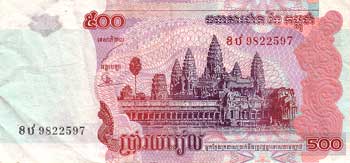 | P54a - 500 Riels, 2002 Issued: 04 April 2003 Serial Number: 9822597 Front: Angkor Wat at center, naga head sculpture at lower left center Back: Bridge spanning Mekong river at Kampong Cham at center Watermark: Baylon sculpture in Angkor Wat Signature: Cheo Chanto Size: 136 x 64 mm | |
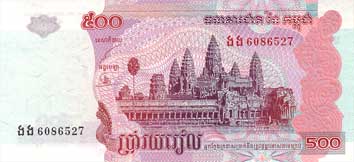 | P54b - 500 Riels, 2004 Issued: 04 April 2003 Serial Number: 6086527-6086538 Front: Angkor Wat at center, naga head sculpture at lower left center Back: Bridge spanning Mekong river at Kampong Cham at center Watermark: Baylon sculpture in Angkor Wat Signature: Cheo Chanto Size: 136 x 64 mm First note of a 10 note notestrap | |
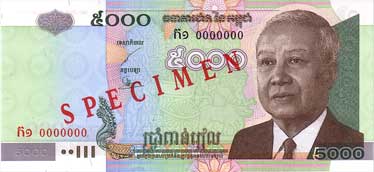 | P55s - 5000 Riels Specimen Note Issued: 06 April 2001 Serial Number: 0000000 Front: King Norodom Sihanouk at right Back: Bridge of Kampong Kdei in Siemreap Province Watermark: Bust of four-faced sculpture UV: fluorescent red and blue fibers, yellow fluorescent outline of Kymer "5000" at center front, yellow fluorescent rectangle around "5000" at front lower right, yellow fluorescent Kymer "5000" over watermark on back Size: 146 x 68 mm | |
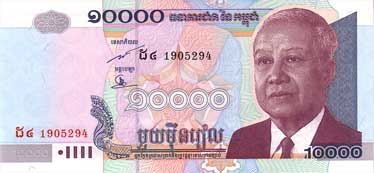 | P56 - 10000 Riels Issued: 06 April 2001 Serial Number: 1905294 Front: King Norodom Sihanouk at right Back: Water festival before Royal Palace Watermark: Bust of four-faced sculpture UV: fluorescent red and blue fibers, yellow fluorescent outline of Kymer "10000" at center front, yellow fluorescent rectangle around "10000" at front lower right, yellow fluorescent Kymer "10000" over watermark on back Size: 146 x 68 mm | |
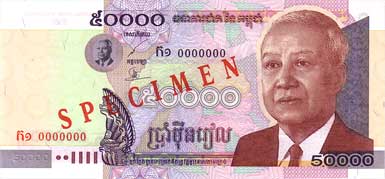 | P57s - 50000 Riels Specimen Note Issued: 06 April 2001 Serial Number: 0000000 Front: King Norodom Sihanouk at right Back: Angkor Wat Watermark: Bust of four-faced sculpture UV: fluorescent red and blue fibers, yellow fluorescent outline of Kymer "50000" at center front, yellow fluorescent rectangle around "50000" at front lower right, yellow fluorescent Kymer "50000" over watermark on back Size: 150 x 70 mm | |
2006-2007 Issue | ||
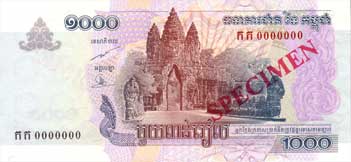 | P58s - 1000 Riels Specimen Note Issue Date: 06 January 2006 Serial Number: 0000000 Front: Victory Gate of Angkor Ttlm temple. On the top left part is the sculpture art of Banteay Srei temple printed by silver ink. Back: Cargo ships in the port of Sihanoukville. Watermark: Stylized lotus flowers Size: 138 x 64 mm | |
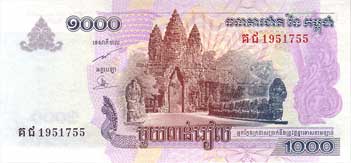 | P58b - 1000 Riels Issued: 06 January 2006 Serial Number: 1951755 Front: Victory Gate of Angkor Ttlm temple. On the top left part is the sculpture art of Banteay Srei temple printed by silver ink. Back: Cargo ships in the port of Sihanoukville. Watermark: Cambodian words Size: 138 x 64 mm | |
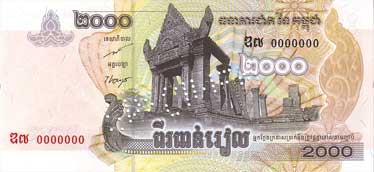 | P59s - 2000 Riels Issued: January 2008 Specimen Note Serial Number: 0000000 Front: Temple at center Back: Women harvesting rice Watermark: Buddha Size: 146 x 68 mm | |
2006-2007 Issue | ||
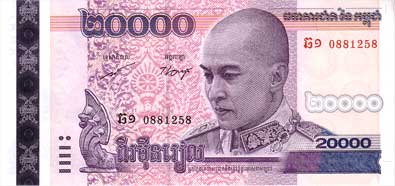 | P-NEW - 20000 Riels Issued: 12 May 2008 to commemorate the King's birthday Serial Number: 0881258 Front: Portrait of King Norodom Sihamoni at center, five-headed naga at lower left, holographic strip with bank logo and 20000, solid security thread with repeating *NBC*, Back: Aerial view of Angkor Thom and four-faced Buddha in Bayon temple Watermark: Buddha Size: 154 x 70 mm King Norodom Sihamoni (born 14 May 1953) is the eldest son of Norodom Sihanouk and Norodom Monineath Sihanouk. Previously Cambodia's ambassador to UNESCO, he was named by a nine-member throne council to become the next king after his father Norodom Sihanouk abdicated in 2004. Before ascending the throne, Sihamoni was best known for his work as a cultural ambassador in Europe and as a classical dance instructor. | |
2012-2013 Issue | ||
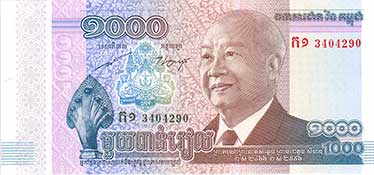 | P-NEW - 1000 Riels Issue Date: 29 January 2013 Serial Number: 3404290 Front: Portrait of King Norodom Sihanouk at center, seven-headed naga at lower left, Coat of Arms at left center Back: Royal Palace throne room; golden swan-shaped float carrying Sihanouk's body. Watermark: Lotus flower pattern Size: 146 x 68 mm | |
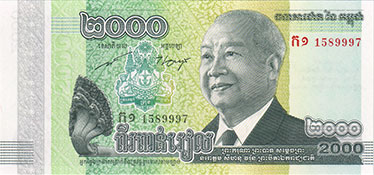 | P-NEW - 2000 Riels Issued: 08 November 2013 Serial Number: 1589997 Front: Portrait of King Norodom Sihanouk at center, seven-headed naga at lower left, Coat of Arms at left center Back: Watermark: Lotus flower pattern Size: 146 x 68 mm The note commemorates 60 years of Cambodia's independence. | |
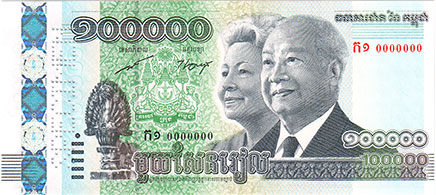 | P-NEW - 100000 Riels Issued: 30 April 2013 Specimen Note Serial Number: 0000000 Front: Portrait of King Norodom Sihanouk and Queen Mother Norodom Monineath at center, seven-headed naga at lower left, Coat of Arms at left center Back: Portrait of King Norodom Sihanouk, Queen Mother Norodom Monineath and their son, the current King Norodom Sihamoni. Watermark: Portrait of King Norodom Sihanouk Size: 170 x 75 mm The note commemorates the 60th birthday of King Norodom Sihanouk. | |